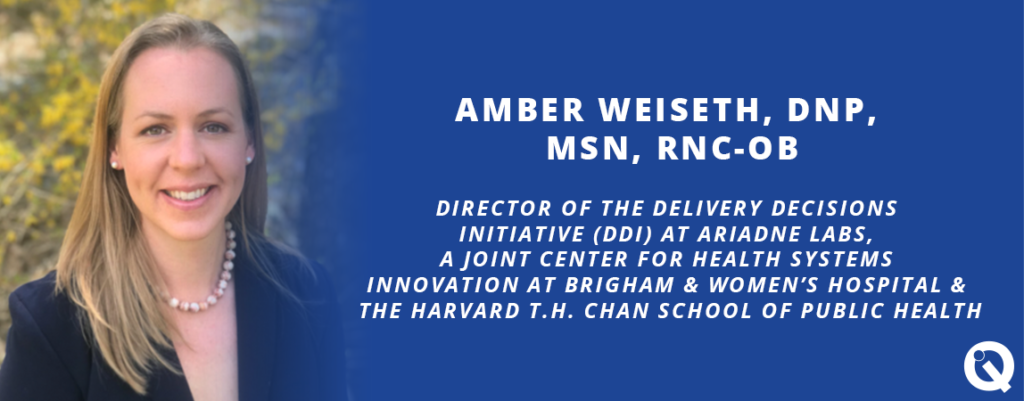Amber Weiseth, DNP, MSN, RNC-OB, is Director of the Delivery Decisions Initiative (DDI) at Ariadne Labs, a joint center for health systems innovation at Brigham and Women’s Hospital and the Harvard T.H. Chan School of Public Health. The Quality Institute, NJ Department of Health, and Ariadne Labs are jointly implementing New Jersey TeamBirth, a shared decision-making model to be used during childbirth. In its first year, the model is being launched in partnership with RWJ Barnabas Health and Virtua at three hospitals and one birthing center.
Ariadne began implementing TeamBirth across the country in 2017. What gaps in the health care system are you trying to address?
One gap is around individual people’s autonomy — the autonomy of a birthing person to make decisions, to be informed, and to participate in their care. The reason behind shared decision making is to value people’s different preferences and lived experiences and to center decision making around the individual. Historically, in childbirth things have been done to patients; we want to change that so that the care team centers around the person who is in labor.
And another gap is communication. We want each person on the team, the nurse, the physician or midwife, and the patient to all have an equal platform for sharing their expertise in a clear way. We want everyone to move forward as a team — where everybody is on the same page.
How critical is communication to the birthing experience?
That’s how TeamBirth came about — trying to find ways for teams to work well together and bridge the gaps in communication. The United States is the only developed country with a continually rising maternal mortality rate. We have this over utilization of interventions such as Cesarean births, where we see a large variation across the country. According to the Joint Commission, the root cause of 80 percent to 90 percent of sentinel events is a failure of communication.
Have your interventions made a difference in racial inequities in patient experience or outcomes?
We completed a pilot in 2018 and 2019 with four hospitals across the country. The goal was to test whether TeamBirth was feasible in different hospital settings and whether people liked it. Our data has been published in three articles in the journal Birth. Our trials revealed that patients and providers — nurses, midwifes, and physicians — all very much liked TeamBirth. Patients valued or had higher ratings in their role in the birth experience. They felt sharing their preferences made a difference in the care they received. And for providers, 90 percent of them recommended TeamBirth to other units; they felt that it was better care for their patients. So not only do patients like it, providers like it. Since then, we’ve seen that in certain hospitals they have been able to lower their C-section rates and sustain those lower rates. In other sites, we’ve seen a reduction in severe complications for birthing people and their babies.
Our current research, which will be submitted for publication later this year, is focused on racial equity in autonomy and shared decision making. Can we reduce some of the inequities in care and experience we see by race and ethnicity by providing TeamBirth care? We’re still completing our analysis, but we are seeing a good indication that TeamBirth makes a difference in reducing these inequities.
You are the first person with a nursing background in this position. How does being a nurse inform your perspective?
My background is in labor and delivery nursing. I’ve been a nurse for almost 20 years and have supported thousands of birthing people and their families during one of the most memorable and important events in people’s lives. Nurses spend more time at the bedside than any other provider. It was not uncommon for me to spend my entire 12-hour shift in one family’s room, taking care of them through their whole birth experience. Nurses are trained and practice in a way that gives them a great deal of insight into what it looks like to take care of patients. Nurses are also great advocates and collaborators because it’s a nurse’s responsibility to work with your physician or your midwife — and if the patient needs a respiratory therapist or a physical therapist, you are coordinating with all those other health care professionals as well. Having experience collaborating with multidisciplinary teams and advocating for patients sets me up well to lead a program that does both.
Finally, nurses are critical implementers within healthcare systems. When we work to implement TeamBirth with hospitals around the United States, it is typically the nurse leaders who manage the project day to day with the support from midwife and physician colleagues. It is a privilege for me to lead and partner with so many incredible nurses, midwives, and doctors in New Jersey and around the country.
We like to ask a question beyond a person’s professional life. Where might we find you on a day off?
I’ve been married 20 years and have four teenagers. So, my husband and I spend a lot of time driving to different sporting events. For me, personally, I love Cross Fit, ballet, and anything outdoors. I love to travel and experience other cultures, especially their food. I’m a total foodie and love to cook, which is helpful because I have so many teenagers to feed.

